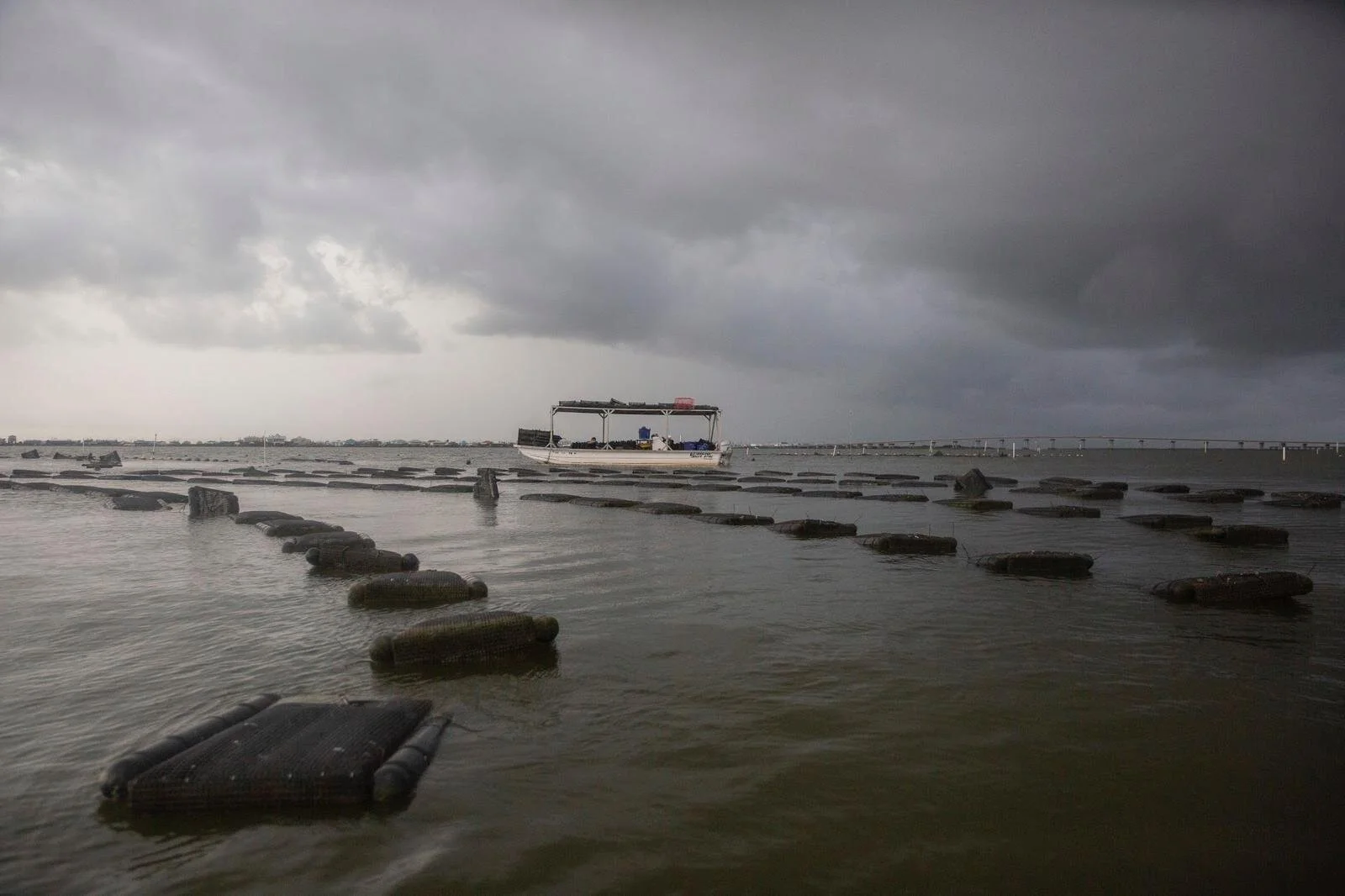The Oyster Farmer Who Took Inspriration From a Colombian Drug Cartel
Meet Scott Maurer of Louisiana Oysters
The Gulf of Mexico is not an easy place to grow oysters. Its geographical location puts it in the path of hurricanes, and the coast off Louisiana also faces the challenge of red tape issues. But Scott Maurer, the chief oyster operator of Louisiana Oyster Co, is an optimist.
The 44-year-old started oyster farming 10 years ago, after the BP Deep Water Horizon oil spill.
“I just fell in love with oysters. I started studying them and doing traditional on-bottom farming and trying to enhance the production of on-bottom leases. Then I switched to modern off-bottom farming techniques while also figuring out everything oysters can do for the environment, from water quality stabilizing to creating a reef for juvenile species; and the bonus of oysters is of course that they are edible!” he says.
Scott Maurer inspecting his oyster baskets
While Louisiana has historically been known for oyster farming, the industry has declined.
“On the Gulf of Mexico, our style of farming is very new and not many people have really perfected what you have to do just yet because there has been a moratorium on oyster leases in Louisiana for 20 years,” Scott says.
“We were trying to get a permit to do shellfish aquaculture, but there is a law in Louisiana that says you can’t put fish in cages. Because shellfish contains the word ‘fish’, we were told that the law prevented shellfish aquaculture. So, we said instead that we wanted to do ‘alternative oyster culture’ and they approved it! However, no new leases were granted so we had to approach the local port commission, ask them to make a special farming zone and give us a permit. Which they did, and here we are today. Farming not on a lease but within a permit zone.”
Hurricanes are one of his biggest headaches. While Hurricane Sally swept through the Gulf in September narrowly missing Louisiana, he wasn’t so fortunate in the weeks leading up to that. In an exceedingly rare occurrence, both Hurricanes Marco and Laura scored direct hits on his part of the coastline. The low-lying Mississippi delta country.
“We were in the cone of error for both of them. A storm track looks like an ice cream cone, the further along the storm gets, the wider the cone and you don’t know exactly where they are going to land. The interesting things about the storms this year is they develop so fast, a matter of days, and it didn’t allow us time to prepare,” Scott says.
“Only once before has there been two hurricanes in the Gulf at one time and this time, here I was in the projected path of both of them. Laura was only projected as a category 1 hurricane, which goes at 70 miles (112km) an hour. It hit as a category four-five and was blowing at 150 miles (241km) an hour when it hit.”
Thankfully, Scott had just enough time to prepare his farm, so losses were minimal this time. It was a close call though. So why does he do it?
“We produce some of the best oysters in the whole entire world. Virginica oysters, otherwise known as the American or Eastern oyster. They’re the same species that are grown from Canada to Texas, but Louisiana is very special in the amount of nutrients and the mixing of waters from the Gulf and Mississippi River. It creates a unique flavor. A lot of oysters in other areas are very oceanic, salt forward and minerally. Ours have a lot more complexity and flavor and they’re very meaty as well,” Scott says.
Some of Scott's freshly harvested premium Louisiana oysters ready for shucking.
“Most areas take about three years to bring an oyster to maturity and we do it in 9-12 months. It’s ridiculously fast, but the amount of work is about the same because with the hurricanes thrown at us it can be a horrendous time.”
It takes a lot of work to get ready for a storm and even more to recover from it.
“We try to prepare months ahead of time rather than when a hurricane is coming toward us. We get cold fronts over here, the wind can blow 50 miles (80km) an hour for a week straight and sustained wind can cause as much damage as one hurricane,” he says.
Because there are so many barriers to entry, there aren’t a lot of oyster farmers in Louisiana anymore, so Scott doesn’t have anyone telling him what works in the current climate. The Australian adjustable long-line system isn’t an option because of the high number of sport fishermen and he’s not allowed pylons, so all his gear has to be floating on lines held in place by buoys and anchors.
And that is where the drug connection comes in.
“I lean towards floating long line sleeper gear, with minimal flotation so when a tidal surge comes, my gear is under the wave action but off the bottom,” he says.
“Going into hurricane season – June to October - I typically run my bags heavier than normal on a floating long line. A lot of people count oysters or split out by the volume of oysters in a bag, but I go by how the gear floats and if we’re expecting bad weather, I run it heavier. I got the idea from seeing a Colombian narco submarine on the news. They run them just below the surface to avoid detection, but it also enables them to plough through waves without creating much disturbance. I figured if it was good enough for cocaine, it’s good enough for oysters.
“If the gear itself is barely positively buoyant, it’s easier to fall under the surface and won’t be thrashed by every wave. A lot of people’s storm plan is to sink the gear, but if you’ve ever stood on a coastline and let waves run over your feet, when the wave goes back it erodes the sand. If I were to sink my gear here, it would bury.
“Here, sinking gear is not an effective storm plan so I need that neutral buoyancy.”
Preparation ahead of Hurricane Laura's landfall as a Cat 4 in August 2020.
Scott has been a SmartOysters customer for about a year. As well as helping him keep track of how many oysters are on the farm during challenging weather conditions, he appreciates how the app responds to a farmer’s needs.
“One of the things I really respected was that Col saw what oyster farmers were going through in the Gulf and on the fly created a way of marking gear within the app, so if you found lost gear it could be sent back to the farmer,” Scott says.
“It really shows someone who is committed to bettering the industry, not just making money. I truly feel they are interested in our success. They are oyster farmers themselves and until you’ve rigged out an entire farm and seen it thrashed in shambles you don’t know what it is like.”
Scott's farm and a freshly shucked oyster on a nice calm day.
You can learn more about Scott and his incredible oysters here.





